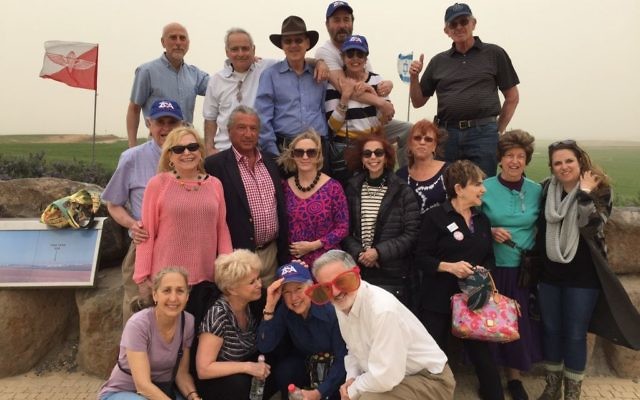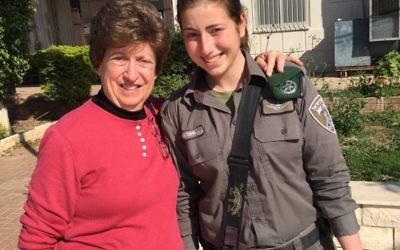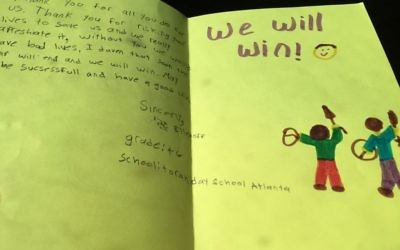Mission to Israeli Borders Opens Eyes, Changes Lives
ZOA mission to Israel fosters new ideas about Gaza and Arab neighbors.
I have bene to Israel many times, but I have never had my life changed in the way it was by the 10-day Zionist Organization of America Purim mission to Israel this year.
My cousin Howard Katzoff, the deputy executive director of the New York office of the ZOA, called my sister in Ohio and me in Atlanta to ask us to join the mission he was planning with Jeff Daube, the director of the ZOA Israel office. Little did I know that I would not be the same person at the end of mission as I was at the start.
The Purim shaloch manot mission was created to bring the joy of Purim to the Magav, the Israeli border police serving between Israel and Samaria (part of the West Bank). They serve in tense places and are not allowed to leave their posts for Purim.
We loaded our bulletproof bus with big plastic bags full of candy and other goodies, as well as personal letters written by children at Jewish schools across the United States, including the Epstein School and Torah Day School of Atlanta.
Our first stop was the most dangerous place, Tzomet Patuach in Samaria. The soldiers there daily face four to five shootings, stabbings, car rammings and other incidents.
The soldiers were thrilled to see us. The commander of the unit, an Israeli Arab Muslim, talked to us. We sang and danced with the soldiers.
When we learned that it was the birthday of a soldier in the watchtower, we formed a semicircle and sang to wish him a happy birthday. One of our mission members up the stairs to hand him a letter and goodies, and the soldier put his hand over his heart, read the letter and wiped tears from his eyes.
No one seems to show these brave border guards how much we care about them, how much we appreciate their protection and how much we pray for them, even in the United States.
The elite unit at the border bases in Tulkarem and Kalkiya is made up of Christians, Jews, Druze and Muslims, all fluent in Arabic and Hebrew. “Do you think we want to live under the oppressive PLO or Hamas or sharia law?” one soldier said. “In Israel, we are free people.”
On Shabbat afternoon, an Arab Muslim newspaper reporter, Khaled Abu Toameh, talked to us about the facts on the ground.
“There will never be a two-state solution,” he said. “There will never be a political peace between Israel and the PLO. Even if you give them 99 percent of all they want, they will not take it. Why? Because their goal is the complete destruction of Israel and the complete dominance of the entire Mideast,” then the world.
We were told that children are being taught in Palestinian schools to hate anyone different from them and to embrace martyrdom as the path to greatness.
A life-changing experience was seeing the “settlements” of Efrat (20 minutes outside Jerusalem) and Sderot (on the Gaza border). These are beautiful, bustling cities of 10,000 and 20,000 people, respectively, with big, modern buildings and homes with bomb shelters.
Sderot has two bomb shelters on every street because the city gets only a 15-second warning when rockets are fired from Gaza. We were so impressed by the residents’ bravery, their faith in G-d and their joy in Torah.
When our bus drove into Sderot, Rabbi David Fendel, who serves the city and a yeshiva where students spend half the year learning Torah and half in the military, greeted us with dancing and singing. We followed as he led the yeshiva boys in a parade of dancing and singing with a Purim-decorated truck blaring its horn.
The most lasting impression occurred at Kibbutz Nahal Oz, which is a five-minute drive from Sderot and is a half-mile and three fields (under which Hamas could be digging tunnels) away from Gaza. We stood at the wire fence separating the kibbutz from the fields and could hear the truck we watched moving along the border road in Gaza.
Who protects the brave kibbutz families? A group of commando-trained volunteers, men and women, called Yatar Israel, an ATV unit that patrols and reacts quickly to capture terrorists in areas out of reach of security vehicles, such as narrow alleys and dirt roads in hills and fields.
Many of them work day jobs, then patrol at night, leaving only a couple of hours for sleep. “My wife and children live here. Of course I am going to be a Yatar volunteer to protect them,” one commando said. “Why do we live here? Because this is our home, and Israel needs us.”
When we asked Yatar volunteer Mieria Pons, who has a 3-year-old and is pregnant, what we can do to help, she mentioned Yatar’s need for bullet- and knife-proof vests, which cost $600. Tax-deductible donations can be sent to Friends of Mishterat Israel, Yatar CTU, P.O. Box 632, Woodmere, NY 11598.
How have our lives been changed by the ZOA mission? We realized how deeply biased the media are and how naive Western thinking is.
The misconceptions include Israel’s border barrier. Only 5 percent is a cement wall. The rest is a wire fence with 24-hour video monitoring and electronic touch sensors. Col. Dani Tirza, who planned the 451-mile fence, said plotting the route was one his hardest responsibilities. He zigzagged the route to try to keep Arab houses and agricultural land together.
After witnessing the unbelievable bravery of our people in Israel, risking their lives to keep Israel safe and strong, we realized that those of us who are not living in Israel must do more to help the soldiers and border police and show them we care.
We are an eternal people, bound to each other through our Torah covenant with G-d, responsible to those who came before us to continue the holy work of ensuring that this sacred gift of the land of Israel will be there for those who come after us.
On the Mount of Olives
One of my holy moments came from our visit to the 3,000-year-old Jewish cemetery on Jerusalem’s Mount of Olives, which has more than 200,000 graves, including prophets and revered rabbis.
But it has been dangerous for Jews to hold burials or visit graves there. It even has been dangerous to travel the streets leading to the cemetery through a heavily Arab area without an armed guard.
There are now 147 monitored surveillance cameras and an extra police presence on the nearby roads and in the cemetery.
For me, it was moving to stand among those graves and have Jewish history come alive in front of my eyes. Standing at the burial site of former Prime Minister Menachem Begin and his wife and looking over the countless white burial monuments of our Jewish people, I realized even more strongly how connected we Jews are to one another, to Torah and to the land of Israel.
That was made more poignant when cousin Howie Katzoff showed us the burial site of our great-grandmother Sima, who immigrated to Israel around 1904 to escape pogroms in Poland and was buried on the Mount of Olives in 1914.
For a brief moment, time stopped for me. My soul was part of hers of every soul buried there.
- Harriet Cortell brings a border police officer a shaloch manot bag and a card for Purim.
- The ZOA mission brought cards such as this one, made by a Torah Day School of Atlanta pupil, to Israeli security personnel.






comments